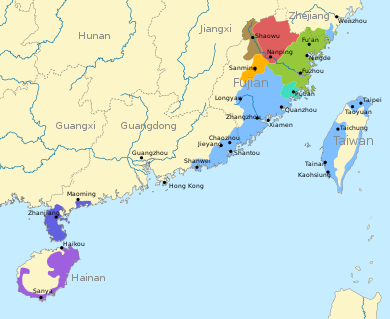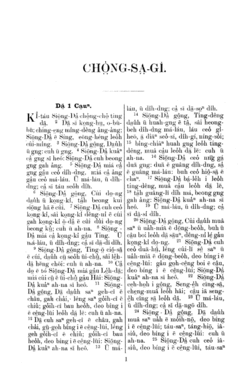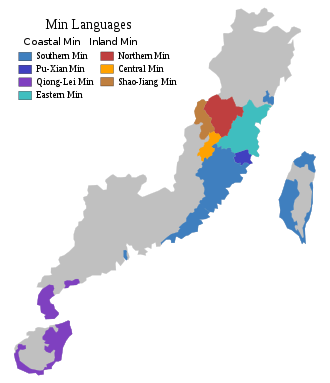Pu-Xian Min
Puxian (Hinghwa Romanized: Pó-sing-gṳ̂/莆仙語; simplified Chinese: 莆仙话; traditional Chinese: 莆仙話; pinyin: Púxiānhuà), also known as Pu-Xian Chinese, Puxian Min, Xinghua or Hinghwa (Hing-hua̍-gṳ̂/興化語; simplified Chinese: 兴化语; traditional Chinese: 興化語; pinyin: Xīnghuàyǔ), is a Sinitic language that forms a branch of Min Chinese.
| Puxian | |
|---|---|
| 莆仙語/莆仙話/興化話 Pó-sing-gṳ̂/Pó-sing-uā/Hing-hua̍-uā | |
| Native to | China, Malaysia, Singapore, Indonesia, Taiwan (Wuqiu), United States (California) |
| Region | Fujian (Putian, parts of Fuzhou and Quanzhou) |
| Ethnicity | Putianese (Han Chinese) |
Native speakers | 2.6 million (2000)[1] |
| Dialects | |
| Chinese characters Hinghwa Romanized(báⁿ-uā-ci̍) | |
| Language codes | |
| ISO 639-3 | cpx |
| Glottolog | puxi1243[2] |
| Linguasphere | 79-AAA-id |
 Pu-Xian Min | |

Puxian is spoken mostly in Fujian province, particularly in Putian city and Xianyou County (after which it is named), parts of Fuzhou, and parts of Quanzhou. It is also widely used as the mother tongue in Wuqiu Township, Kinmen County, Fujian Province, Republic of China (Taiwan). More than 2000 people in Shacheng, Fuding in northern Fujian also speak Puxian.[3] There are minor differences between the dialects of Putian and Xianyou.
Overseas populations of Puxian speakers exist in Malaysia, Indonesia and Singapore. Speakers of Puxian are also known as Henghua, Hinghua, or Xinghua.
History
Before the year 979 AD, the Puxian region was part of Quanzhou county and people there spoke a form of Southern Min.[4][5] due to its origin in the past.
In 979 AD, during the Song Dynasty, the region was administratively separated from Quanzhou and the Chinese spoken there developed separately from the rest of Southern Min. Due to its proximity with Fuzhou, it absorbed some elements of Eastern Min, but its basic linguistic characteristic i.e. grammar and most vocabulary is based on Quanzhou dialect.[6]
Puxian Min has 62% cognates with Quanzhou dialect (Southern Min) and only 39% cognates with Fuzhou dialect (Eastern Min).[7]
Characteristics
Differences with Southern Min dialects
Puxian differs from most Southern Min varieties in several ways:
- The vowel 'a' is replaced by /ɒ/ (o̤) in most cases, e.g. 腳 ko̤ "leg".
- The vowel 'ư' /ɯ/ is replaced by /y/ ('ü'), e.g. 魚 hṳ "fish".
- In Putian 'ng' has changed to /uŋ/ except after zero initial and h- (notation: ng), e.g. 湯 tung "soup".
- The vowel /e/ is often replaced by /ɒ/ o̤, e.g. 馬 bo̤ "horse".
- Where Quanzhou has 'ĩ' and Zhangzhou has 'ẽ', the corresponding Putian vowel is 'ã', e.g. 病 baⁿ "sick", where ⁿ indicates a nasalized vowel.
- The vowel 'io' is replaced by 'iau' (notation: a̤u), e.g. 笑 ciao "laugh". This also holds for nasalized vowels, e.g. 張 da̤uⁿ corresponding to Quanzhou tioⁿ.
- Nasals 'm' sometimes occur in place of voiced stops 'b', e.g. 夢 mang vs. Quanzhou bang.
- Initial consonant 'ng' replaces 'g' e.g. 五 'ngo' vs. Quanzhou 'go'.
- There is a loss of distinction between voiced and unvoiced stops, e.g. the sounds /b/ and /p/ both correspond to the same phoneme and occur in free variation.
Borrowings from Eastern Min
- Wife 老媽 (Lau Ma)
Phonology
Puxian has 15 consonants, including the zero onset, the same as most other Min varieties. Puxian is distinctive for having a lateral fricative [ɬ] instead of the [s] in other Min varieties, similar to Taishanese.
Puxian has 53 finals and 6 phonemic tones.
Initials
| Bilabial | Alveolar | Lateral | Velar | Glottal | ||
|---|---|---|---|---|---|---|
| Plosive | unaspirated | p 巴 (b) | t 打 (d) | k 家 (g) | ʔ 烏 | |
| aspirated | pʰ 彭 (p) | tʰ 他 (t) | kʰ 卡 (k) | |||
| Nasals | m 麻 (m) | n 拿 (n) | ŋ 雅 (ng) | |||
| Fricatives | voiceless | ɬ 沙 (s) | h 下 (h) | |||
| voiced | β* | |||||
| Affricates | unaspirated | ts 渣 (c) | ||||
| aspirated | tsʰ 査 (ch) | |||||
| Approximant | l 拉 (l) | |||||
- β (only appears in connected speech. It's a result of consonant mutation of [p])
Finals
Puxian Min has 53 finals (including nasalised finals)
| Vowel | Diphthong | Nasal | Glottal | |
|---|---|---|---|---|
| no glide | a 鴉 (a) | au 拗 (au) | aŋ 王 (ang) | aʔ 壓 (ah) |
| ɒ 奥 (o̤) | ɒŋ 用 (o̤ng) | ɒʔ 屋 (o̤h) | ||
| ɔ 科 (eo) | ɔu 烏 (o) | ɔŋ 温 (eong) | oʔ 熨 (eoh) | |
| e 裔 (a̤) | ai 愛 (ai) | ɛŋ 煙 (eng) | ɛʔ 黑 (eh) | |
| œ 改 (e̤) | œŋ 換 (e̤ng) | œʔ 郁 (e̤h) | ||
| ŋ 伓 (ng) | ||||
| /-i-/ | i 衣 (i) | iu 油 (iu) | iŋ 引 (ing) | iʔ 益 (ih) |
| ia 夜 (ia) | iau 要 (a̤u) | iaŋ 鹽 (iang) | iaʔ 葉 (iah) | |
| /-u-/ | u 夫 (u) | ui 位 (ui) | uŋ 黄 (ng) | |
| ua 画 (ua) | ɔi/ue 歪 (oi) | uaŋ 碗 (uang) | uaʔ 活 (uah) | |
| /-y-/ | y 余 (ṳ) | yŋ 恩 (ṳng) | yʔ 役 (ṳh) | |
| yɒ 安 (io̤ⁿ) | yɒŋ 羊 (io̤ng) | yɒʔ 藥 (io̤h) |
| Chinese character | 黃 (ńg) | 方 (hng) | 漲 (dn̂g) | 幫 (bng) | 光 (gng) | 兩 (nn̄g) | 毛 (mńg) |
| Putian | uŋ | huŋ | tuŋ | puŋ | kuŋ | nuŋ | muŋ |
| Xianyou | ŋ̍ | hŋ̍ | tŋ̍ | pŋ̍ | kŋ̍ | nŋ̍ | mŋ̍ |
| IPA | ã | ẽ | ɛ̃ | ĩ | ỹ | ɒ̃ | iã | yã | uã | aĩ | aũ | uĩ | iũ |
| Romanization | aⁿ | a̤ⁿ | a̤ⁿ | e̤ⁿ | o̤ⁿ | iaⁿ | io̤ⁿ | uaⁿ | oiⁿ | a̤uⁿ | |||
| Romanized IPA | ã | ẽ | ø̃ | ɒ̃ | iã | yɒ̃ | uã | oĩ | ɛũ |
| Chinese character | 爭 (caⁿ) | 還 (há̤ⁿ) | 段 (dē̤ⁿ) | 三 (so̤ⁿ) | 鼎 (diáⁿ) | 張 (da̤uⁿ) | 看 (kua̍ⁿ) | 飯 (bōiⁿ) | 贏 (ió̤ⁿ) |
| Xianyou | tsã | hĩ | tỹ | sɒ̃ | tiã | tiũ | kʰuã | puĩ | yɒ̃ |
| Putian | tsa | hi | tø | sɒ | tia | tiau | kʰua | puai | yɒ |
Tone
| Tone | Ing-báⁿ 陰平 | Ing-siō̤ng 陰上 | Ing-kṳ̍ 陰去 | Ing-ci̍h 陰入 | Ió̤ng-báⁿ 陽平 | Ió̤ng-kṳ̍ 陽去 | Ió̤ng-ci̍h 陽入 |
| Putian | ˥˧˧ (533) | ˦˥˧ (453) | ˦˨ (42) | ʔ˨˩ (ʔ21) | ˩˧ (13) | ˩ (11) | ʔ˦ (ʔ4) |
| Xianyou | ˥˦˦ (544) | ˧˧˨ (332) | ˥˨ (52) | ʔ˨ (ʔ2) | ˨˦ (24) | ˨˩ (21) | ʔ˦ (ʔ4) |
Register
| Chinese character | 買 | 黃 | 生 | 領 | 師 | 兩 | 火 | 壁 | 著 |
| Colloquial | pe | ŋ̍ | ɬã, tsʰã | nia | ɬai | nŋ̍ | hoe | pia | tieu |
| Literary | mai | hɒŋ | ɬɛŋ | liŋ | ɬo | løŋ | hɒ | piʔ | tøʔ |
Assimilation
新婦房 ɬiŋ pu paŋ → ɬiŋ mu βaŋ
青草 tsʰɔŋ tsʰau → tsʰɔŋ nau
Comparison between Putian Min and Quanzhou Min Nan
| Chinese character | 埋 (lit.) | 萬 (lit.) | 人 (lit.) | 入 | 危 (lit.) | 逆 | 內 | 諾 |
| Putian | mai | man | tsin | tsiʔ | kui | kiʔ | tue | tɔʔ |
| Quanzhou | bai | ban | lin | dzip | ɡui | ɡiak | lue | lɔk |
Sentence-final particles
- ah (啊): used to express exclamation.
- lah (啦): used to stress or for adding emotional effect to your words.
- neh (呢): used for questioning.
- nɔ (唔): used to express emotion.
- yɔu (哟): used to denote obviousness or contention.
Romanization
Hing-hua̍ báⁿ-uā-ci̍ (興化平話字) is the Romanization system for Puxian Min. It has 23 letters: a a̤ b c ch d e e̤ g h i k l m n ng o o̤ p s t u ṳ.
The Romanization only needs five tone marks for seven tones:
- 陰平 Ing-báⁿ (unmarked)
- 陰上 Ing-siō̤ng ˆ (â)
- 陰去 Ing-kṳ̍ ˈ (a̍)
- 陰入 Ing-ci̍h (unmarked)
- 陽平 Ió̤ng-báⁿ ́ (á)
- 陽去 Ió̤ng-kṳ̍ - (ā)
- 陽入 Ió̤ng-ci̍h ˈh (a̍h)
| IPA | Puxian Min (Xinghua) | Fuzhou |
| pʰ | p | p |
| tʰ | t | t |
| kʰ | k | k |
| p | b | b |
| t | d | d |
| k | g | g |
| tsʰ | ch | ch |
| ts | c | c |
| Tone | 陰平 Ing-báⁿ | 陰上 Ing-siō̤ng | 陰去 Ing-kṳ̍ | 陰入 Ing-ci̍h | 陽平 Ió̤ng-báⁿ | 陽去 Ió̤ng-kṳ̍ | 陽入 Ió̤ng-ci̍h |
| Báⁿ-uā-ci̍ | a | â | a̍ | ah | á | ā | a̍h |
| Pe̍h-ōe-jī | a | á | à | ah | â | ā | a̍h |
References
- Puxian at Ethnologue (18th ed., 2015)
- Hammarström, Harald; Forkel, Robert; Haspelmath, Martin, eds. (2017). "Pu-Xian Chinese". Glottolog 3.0. Jena, Germany: Max Planck Institute for the Science of Human History.
- "A Further Study on Puxian Dialect Zone in Aoyao Village,Fuding--《Journal of Longyan University》2013年01期". en.cnki.com.cn.
- "世界上根本無閩南語 ~ 王華南". www.taiwanus.net.
- "Archived copy". Archived from the original on 2015-06-21. Retrieved 2015-06-19.CS1 maint: archived copy as title (link)
- http://baike.baidu.com/view/909013.htm
- 李如龍、陳章太:《論閩方言內部的主要差異》,《閩語硏究》 pg 58-138. 北京:語文出版社, 1991.
External links
| Pu-Xian Min test of Wikipedia at Wikimedia Incubator |
| Pu-Xian Min test of Wiktionary at Wikimedia Incubator |
| Pu-Xian Min repository of Wikisource, the free library |
